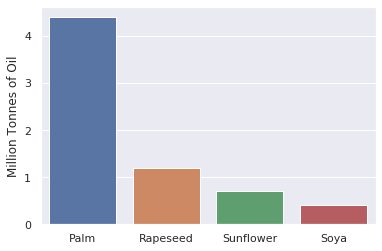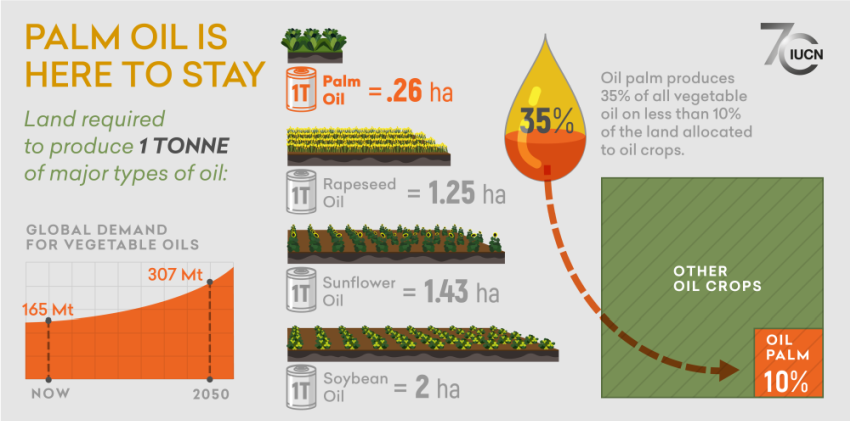Palm oil is a widely-used edible vegetable oil derived from the fruits of the oil palms. In fact it’s so widely used that it’s hard to avoid. Name any processed food product you might buy at the supermarket, and chances are it has palm oil in it. Name any brand of shampoo, lipstick, or soap and chances are they have palm oil in their products. Over the years, organisations such as Greenpeace have spoken out against it, citing environmental and ethical concerns, and more and more people are becoming aware of the problem. Should you continue to consume products with it? What would happen if everyone boycotted it? After reading through many scientific papers and publications on the matter, I can only say that the issue isn’t as black-and-white as it has been purported to be.
The Good
One reason that palm oil is in everything is that it’s so incredibly cheap. The reason it’s so incredibly cheap is that palm oil plantations are so incredibly efficient. To better understand what I mean by that, imagine for a moment that you’re an oil producer. You have 1 hectare (10,000 ![]() ) of land and 1 year to grow your crops. Your aim is to produce as much oil as you can with the resources you have. You quickly look up the yields of different oil crops before you make a decision, and they look something like this:
) of land and 1 year to grow your crops. Your aim is to produce as much oil as you can with the resources you have. You quickly look up the yields of different oil crops before you make a decision, and they look something like this:

You see that oil palm crops can produce about 4.4 million tonnes of oil on average, but rapeseed can only produce about 1 million tonne while sunflower and soy don’t even manage that. In truth, palm oil yields can be as high as 6 to 8 million tonnes1. Which crop do you choose?
Here’s another infographic from IUCN explaining the same thing2.

The other reason palm oil is so profitable is that producers grow it on newly cleared forests, so they can use the profit from timber to subsidise setting up a new plantation. This deforestation is the main environmental concern people have with consuming palm oil. These concerns led to the establishment of the Roundtable on Sustainable Palm Oil (RSPO), which gives certifications to companies that produce sustainable palm oil. The actual guidelines that must be followed by the companies vary from country to country due to the differing laws. This means that RSPO tailor-makes sustainability guidelines for each country depending on their unique situation3.
Palm oil producers are assessed for certification once every 5 years. If certified, they will be assessed annually to ensure that they still comply with the guidelines. The end result is that 13.47 million tonnes of palm oil in the world is RSPO certified – that’s about 19% of the world’s palm oil production4. Also, many countries choose to develop their own sustainability standards for palm oil, such as the Malaysian Palm Oil Board and the Indonesian Sustainable Palm Oil.
The Bad
About 85% of the world’s palm oil comes from Malaysia and Indonesia, both of whom in recent years have focused on increasing the land used for palm oil production. A report published in 2018 claims that between 1999 and 2015 half of the Bornean orangutan population “was affected by logging, deforestation, or industrialized plantations”, with the biggest offender being “land clearance”5. Another report from IUCN claims that industrialised plantations have affected 193 species of animals all over the world2.
Eyes on the Forest report that after about a decade of promises by multiple brands on ‘zero deforestation’, illegal plantations have continued operating in critical wildlife areas to the point of industrialising more than 75% of the Tesso Nilo national park, Indonesia. Home to orangutans, elephants, and tigers, the national park is now a den of illegal plantations that sneak their oil in the global supply chain of brands that have promised their consumers a sustainable and deforestation-free product6.
It is clear that the effects of industrialised plantations on the environment are bad and we haven’t even started talking about the greenhouse gas emissions of clearing a forest or the impact on the climate of having fewer and fewer trees. Indonesia happens to be the world’s third highest greenhouse gas producer – and that’s simply because of deforestation7.
The Ugly
Notice how I said “industrialised plantations” and “illegal plantations” instead of “palm oil plantations”? The destruction caused due to palm oil plantations is not happening because the producers are growing palm oil – as mentioned before, had the producers chosen to grow any other type of oil they would have to clear out considerably more land and use up a lot more resources. The problem is not unique to palm oil. The death and environmental destruction we talk about is happening due to the plantations themselves – a lot of them are illegal and even those that aren’t are severely impacting biodiversity6.
But what about certified plantations? Turns out certification might not mean as much as we think it does. WWF has criticised the RSPO in 2016 for not properly policing sustainable palm oil. They felt that the RSPO standards didn’t do anything to ensure that only legal palm oil was entering the supply chain, and neither did they police greenhouse gas emissions nor ban use of harmful chemicals8.
The change is happening, but too slowly – in 2013 only half of all certified palm oil was able to sell8,9. If there is no financial incentive for the producers to get their oil certified, then they just won’t comply with the RSPO guidelines. According to Greenpeace, even the producers that do agree to follow RSPO guidelines often don’t as the RSPO has no real way of enforcing them – thus being “as much use as a chocolate teapot” in Greenpeace’s own words10.
Malaysia and Indonesia both increased their land used for palm oil plantations massively in the early 1990s. However, the increase in area farmed from 1990 to 2005 was carried out by replacing other agricultural crops with palm oil on pre-existing agricultural land. Some say that if Malaysia is to be criticised for deforestation due to palm oil production, then the same criticism should apply to countries like the UK for agricultural activities, since agriculture is the leading cause of deforestation worldwide11. The problem of deforestation and habitat loss is a much more general one. All land used for agriculture was once cleared of its natural habitat, whether that was done few centuries ago or a few decades ago. Growing global demand for food leads to growing deforestation worldwide.
The Solution?
It’s complicated. Boycotting palm oil is only going to lead to more habitat destruction and loss of species. Palm oil producers won’t shut down their oil plantations and walk away. They will move on to a different crop which will be undeniably worse for the environment. They will consume more land and water resources and generate a bigger carbon footprint than they did before. The world will move on to boycotting sunflower oil, but the problem of deforestation due to agriculture in an attempt to meet growing demands worldwide will not go away. One way we can deal with this is to switch to a diet that uses up fewer land and water resources – such as adopting a plant-based diet instead of a meat-based diet.
Certification for sustainable palm oil exists, but it is a poor metric to judge its environmental impact. For now, it seems like it’s the only metric we have and the very least we can do is purchase products with certified sustainable palm oil. We can always do more than that – not by boycotting palm oil, but by raising awareness that this isn’t an issue exclusive to palm oil production, and by pushing for changes in the industry itself and how it is regulated by governments.
References
Title photo by Teodor Kuduschiev on Unsplash
- 1.Rupilius W, Ahmad S. Palm oil and palm kernel oil as raw materials for basic oleochemicals and biodiesel. Eur J Lipid Sci Technol. Published online April 2007:433-439. doi:10.1002/ejlt.200600291
- 2.Meijaard E. Palm Oil and Biodiversity. IUCN. Published 2018. https://www.iucn.org/resources/issues-briefs/palm-oil-and-biodiversity
- 3.RSPO Malaysia. RSPO National Interpretations documents. RSPO. Published 2018. https://www.rspo.org/key-documents/certification/rspo-national-interpretations
- 4.RSPO. Impact. RSPO. https://www.rspo.org/impacts
- 5.Voigt M, Wich SA. Global Demand for Natural Resources Eliminated More Than 100,000 Bornean Orangutans. Current Biology. 2018;28(5):761-769. doi:https://doi.org/10.1016/j.cub.2018.01.053
- 6.Eyes on the Forest. Enough Is Enough. EoF; 2018:3. https://eyesontheforest.or.id/reports/investigative-report-enough-is-enough-jun-2018
- 7.Greenpeace UK. Palm Oil. Greenpeace. https://www.greenpeace.org.uk/challenges/palm-oil/
- 8.World Wide Fund For Nature. Palm Oil Scorecard. WWF. Published September 2016. https://palmoilscorecard.panda.org/file/WWF_Palm_Oil_Scorecard_2016.pdf
- 9.Balch O. Sustainable palm oil: how successful is RSPO certification? The Guardian. Published July 4, 2013. https://www.theguardian.com/sustainable-business/sustainable-palm-oil-successful-rspo-certification
- 10.Greenpeace UK. 5 problems with “sustainable” palm oil. Greenpeace. Published November 1, 2019. https://www.greenpeace.org.uk/news/5-problems-with-sustainable-palm-oil/
- 11.Ayodele T. African Case Study: Palm Oil and EconomicDevelopment in Nigeria and Ghana;Recommendations for the World Bank’s 2010 Palm Oil Strategy. Initiative for Public Police Analysis. Published August 2010. http://www.ippanigeria.org/articles/African%20Case%20Study%20Palm%20Oil%20and%20Economic%20Development.pdf
